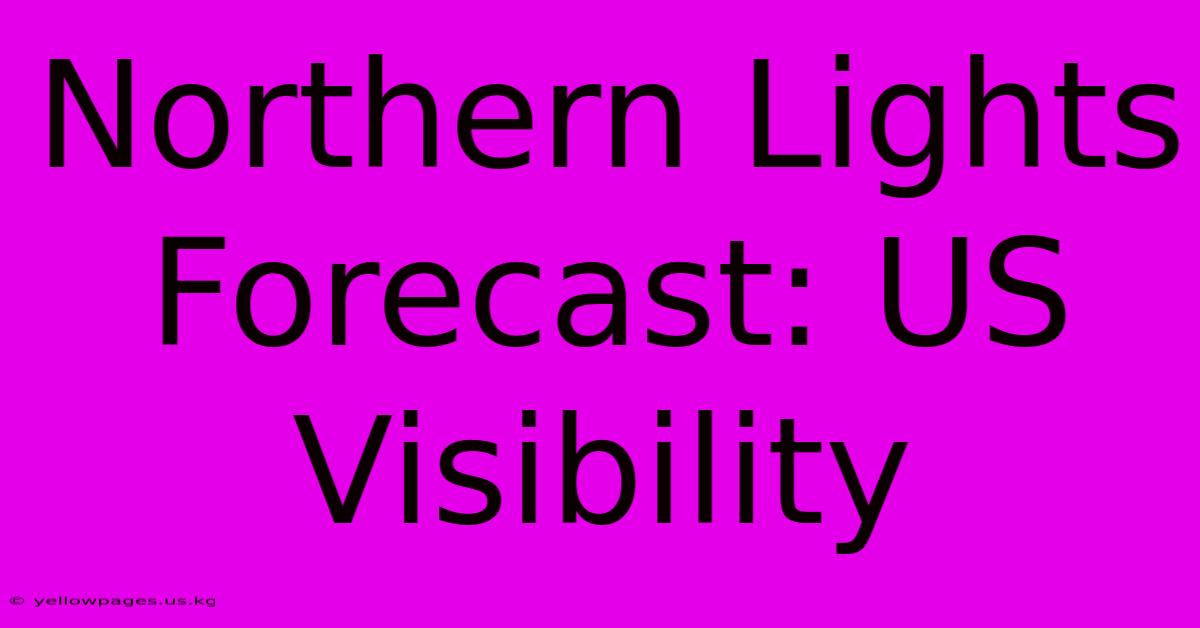Northern Lights Forecast: US Visibility

Discover more detailed and exciting information on our website. Click the link below to start your adventure: Visit Best Website trendingnews.us.kg. Don't miss out!
Table of Contents
Northern Lights Forecast: US Visibility – When and Where to See the Aurora Borealis
The Northern Lights, or Aurora Borealis, are a breathtaking natural phenomenon that captivates viewers worldwide. Witnessing this celestial dance of light is a bucket-list item for many, but knowing when and where to see them in the US requires some planning and a bit of luck. This guide provides a comprehensive overview of the Northern Lights forecast for US visibility, helping you maximize your chances of witnessing this spectacular event.
Understanding the Aurora Forecast
The aurora's visibility depends on several factors, primarily solar activity. The sun constantly emits charged particles; when these particles collide with the Earth's atmosphere, they create the mesmerizing displays of light we see as the aurora. The strength of these solar storms is measured using the Kp index, a scale from 0 to 9, with higher numbers indicating stronger geomagnetic storms and a greater chance of aurora sightings.
Several websites and apps provide real-time aurora forecasts, utilizing data from satellites and ground-based magnetometers. These forecasts predict the Kp index and provide visualizations of the aurora's potential visibility. Regularly checking these resources is crucial for planning your aurora viewing trip.
Key Factors Affecting US Visibility:
- Kp Index: As mentioned, a higher Kp index means a greater chance of seeing the aurora. For US viewers, a Kp index of 5 or higher often increases the likelihood of sightings in northern states.
- Geomagnetic Latitude: The further north you are, the better your chances. Northern states like Alaska, Maine, and Washington are prime locations.
- Light Pollution: Avoid areas with significant light pollution. Darker skies allow for clearer viewing of the aurora. National parks and areas far from city lights are ideal.
- Weather Conditions: Clear skies are essential. Cloud cover will completely obscure the aurora. Check weather forecasts before heading out.
- Time of Year: The aurora is visible year-round, but winter offers longer periods of darkness, significantly increasing your viewing opportunities.
Best Locations in the US for Northern Lights Viewing
While Alaska offers the best chances due to its proximity to the auroral oval, several other US states offer opportunities to witness this celestial display, albeit less frequently.
Top Locations:
- Alaska: Fairbanks is a popular destination due to its high latitude and well-established aurora viewing infrastructure. Other Alaskan locations, including Denali National Park, offer stunning views.
- Maine: Northern Maine, particularly areas along the coast, provide some of the best viewing options in the contiguous US. Acadia National Park offers beautiful scenery and potentially dark skies.
- Washington State: Northern Washington State, especially near the Canadian border, can experience aurora displays during periods of high solar activity.
- North Dakota: Similar to Washington, North Dakota provides chances for viewing, though sightings might be less frequent.
- Montana & Minnesota: While less likely than the states mentioned above, these northern states have witnessed auroral displays during strong geomagnetic storms.
Tips for Maximizing Your Chances of Seeing the Aurora
- Plan your trip during periods of high solar activity: Monitor aurora forecasts and plan your trip accordingly.
- Find a dark location: Get away from city lights for the best viewing experience.
- Be patient: Auroral displays can be fleeting, and sometimes you might need to wait for a while before seeing anything significant.
- Dress warmly: Northern nights can be extremely cold, especially during winter.
- Bring a camera: Capture the beauty of the Northern Lights. A tripod and a camera capable of long exposures will help you get amazing shots.
Conclusion
Witnessing the Northern Lights is an unforgettable experience. By understanding the aurora forecast, choosing a suitable location, and being patient, you significantly increase your chances of seeing this breathtaking natural wonder in the US. Remember to check forecasts regularly, plan your trip during periods of high solar activity, and enjoy the magic of the aurora borealis!

Thank you for visiting our website wich cover about Northern Lights Forecast: US Visibility. We hope the information provided has been useful to you. Feel free to contact us if you have any questions or need further assistance. See you next time and dont miss to bookmark.
Featured Posts
-
Football Officials Citrus Bowl Referee Review
Jan 01, 2025
-
College Bowl Games Schedule Nye
Jan 01, 2025
-
Lsu Football Opt Outs Texas Bowl Depth Chart
Jan 01, 2025
-
Michigans Smart 2025 Mdards Advice
Jan 01, 2025
-
Kentucky Basketball Resolutions
Jan 01, 2025
